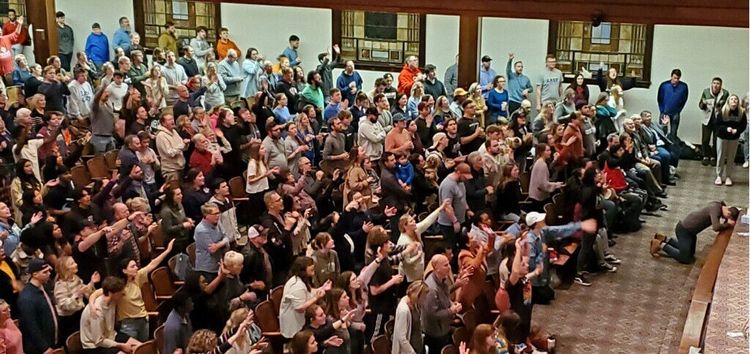Here's how I'm thinking about COVID right now.
TL;DR—Don't look at case rates. Look at hospitalization numbers.
My personal risk—and likely yours—of serious illness, hospitalization, or death due to COVID is incredibly low. More and more, COVID is becoming something that I can "live with." I'm vaccinated, boosted, and I know that we can treat COVID more effectively than we did 18 months ago. All in all, I feel pretty safe from COVID, even if I were to catch it.
That question—"What's safe?"—has been the major question driving much of my personal response to COVID. Staying home, wearing a mask, getting vaccinated—those actions have all been in the service of keeping myself safe. Of course, on my best days, I also took action in the service of keeping others safe. I wanted to do what I could to prevent the spread of COVID.
But that question of my safety is no longer the right question (if it ever were). My long-term safety from COVID is now darn near guaranteed. However, that's not what really matters right now as I consider how best to respond to the next leg of this pandemic.
The question that matters is, "What's responsible?"
Imagine a crowded parking lot after a concert or sporting event. Nearly everyone has large, modern cars or SUVs with 5-star safety ratings. Nearly everyone has seatbelts on. In that scenario, it would be safe for me to try to get out of the parking lot as fast as I could. My SUV and a few others might get a little dented; few if any of us would get injured; we'd all be safe.
But now imagine that almost everyone has the same attitude as me. Even more cars would be dented; even more people—though, not that many—would get hurt.
And now imagine that the nearest hospital is full.
That's the situation we're in right now with COVID. Anecdotally, I have family and friends who are being directly affected by the most recent healthcare crunch caused by COVID: a family member with awful spine pain who has had a surgery rescheduled three times; a friend's family member who waited 30 hours for a hospital bed; a relative who can't get monoclonal antibodies because the state was out. Just didn't have enough for everyone. That was all in the past 2 weeks.
If you're like me, we've spent the past year staring at COVID-case rates. We did that because we used to be able to draw pretty straight, predictable lines between the number of case rates, the number of hospitalizations, and the number of deaths.
But with the mathematical complications of the various stages of vaccinations; the number of people previously infected; and the COVID variants in the air, that case-load number has become less and less helpful as a metric to answer "How bad is this?". Sure 2,000 people got COVID today; but 0.002% of them will die, so everything fine's right?
But a hospital doesn't deal in percentages. A hospital has a finite number of beds and a finite number of healthcare staff. And when those beds are full—and those staff exhausted—then the question I have to ask myself is, "What's the responsible thing for me to do?" Is it to think solely of my own almost guaranteed safety? Or should I think through the repercussions of what happens when 500,000 people who think just like me are all bouncing off each other like SUVs in a parking lot?
Here come some numbers.
DC keeps track of the percentage of COVID-cases that had to be hospitalized. In recent weeks, that percentage has gone down. That's good news though, right? But, remember, hospitals don't work in percentages but real numbers.
At the beginning of December, DC had around 77 people catching COVID each day. And 5% of those cases were being hospitalized. Which means about 4 folks a day were heading to the hospital because they caught COVID. On December 1 DC had 72 total people hospitalized with COVID. Considering the size of our city and hospitals, that's not so bad.
Fast forward to today. The percentage of people being hospitalized has gone down to 2.5%! Great news! It seems that if you catch Omicron, you're less likely to get seriously ill.
However, Omicron gets (many) more people sick (much) faster. DC now averages two thousand cases per day (a 28x increase from December 1). Which means that 50 people folks a day are needing to be hospitalized for COVID. And that tracks with our hospitalization numbers. 350 people are currently hospitalized with COVID in DC hospitals; a 5x jump in less than a month.
If you glossed over those numbers the takeaway is this: even if Omicron is less severe and even if my and your personal percentage-chances of getting seriously ill are wildly low—the sheer massive numbers of people catching COVID are pushing many cities and states towards a healthcare crisis.
Since that's true, then I (and, preferably, hundreds of thousands of others) have to think beyond my own personal safety and risk tolerance. I have to think about what happens when everyone assumes they're all safe and are okay with the risk—and then simple multiplication starts taking effect and you have hospitals who can no longer provide care.
As for what my family is doing: we're basically back in the "flatten the curve" days of March 2020. We're staying home as much as we can; doing outdoor activities (with masks when near others); not doing indoor dining or activities. We're watching city hospitalization numbers and as long as they keep going up by double digits each day (and double-digit percentages each week), we feel this is the responsible thing to do.



Member discussion